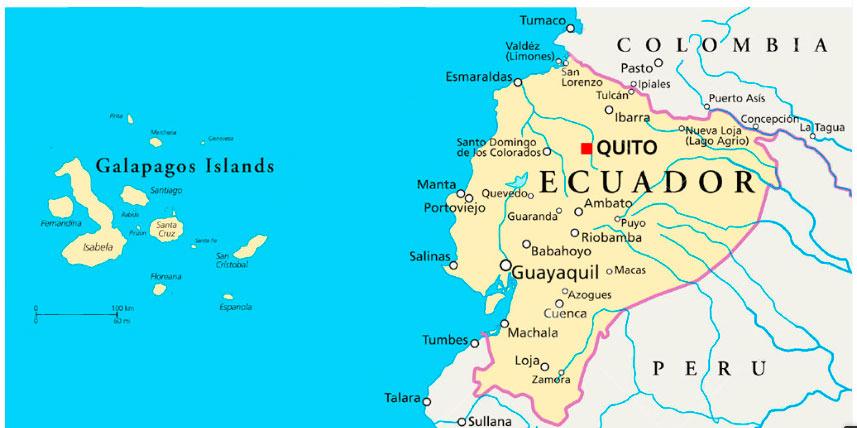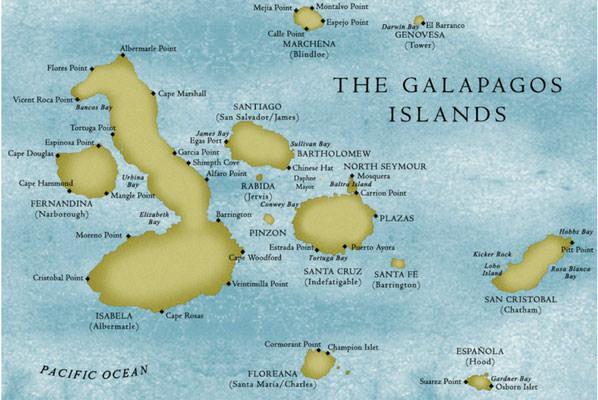The Galapagos Islands Geography, Climate and Brief History
Galapagos Islands Geography: A most-read guide before embarking on your Galapagos Trip. A bit of Galapagos geography, climate and history. Situated right on the Equator, the Galapagos Islands are an archipelago of volcanic islands that are distributed on either side of the Equator and surrounds the center of the Western Hemisphere. It is located 906 km west of continental Ecuador.

Galapagos Geography
The Galapagos Province of Ecuador, the Galapagos National Park, and the Galapagos Marine Reserve are made up of the Galapagos Islands and their surrounding waters. With a population of just over 25,000, the principal language on the islands is Spanish.
The Galapagos Islands are made up of 18 main islands with each island measuring at least 1 km2 in land area.
Santa Cruz is the main island and population center for the Galapagos.
- It may not be the largest of the Galapagos Islands but it considered the most important.
- It is situated in the center of the Galapagos archipelago.
- It is the headquarters for the Galapagos National Park Service and also where the Charles Darwin Research Station and Giant Tortoise Preserves are located.

The main islands:
- Baltra (South Seymour) Island
- Bartolomé (Bartholomew) Island
- Darwin (Culpepper) Island
- Española (Hood) Island
- Fernandina (Narborough) Island
- Floreana (Charles or Santa María) Island
- Genovesa (Tower) Island
- Isabela (Albemarle) Island
- Marchena (Bindloe) Island
- North Seymour Island
- Pinzón (Duncan) Island
- Pinta (Louis) Island
- Rábida (Jervis) Island
- San Cristóbal (Chatham) Island
- Santa Cruz (Indefatigable) Island
- Santa Fe (Barrington) Island
- Santiago (San Salvador, James) Island
- Wolf (Wenman) Island
The minor islands:
- Daphne Major
- South Plaza Island
- Nameless Island
- Roca Redonda
How To Get to the Galapagos Islands
There are no international flights that will take you directly to the Galapagos. You will first need to travel to Ecuador. From Ecuador, the only way to proceed to Galapagos is by airplane.
You will first need to get to either the cities of Quito and Guayaquil on mainland Ecuador. Once you are in mainland Ecuador, you can reach the Galapagos by traveling by plane to the airports on either Baltra Island or San Cristobal Island. From the Galapagos Islands airports, you will then transfer to the hotels in the port towns of the islands.
Galapagos History
It is not clear who the first visitors of the archipelago were but the first historical recording was on 10 March 1535 when Spaniard Fray Tomas de Berlanga sailed to Peru, and his vessel drifted off course and landed his ship on the islands.
In about 1570, the Galapagos Islands appeared on the maps of Gerardus Mercator and Abraham Ortelius named as “Insulae de los Galopegos” (Islands of the Tortoises). It wasn’t until 12 February 1832 that Ecuador annexed the Galapagos Islands and named them the Archipelago of Ecuador.
It was on 15 September 1835 that one the Galapagos Islands’ most famous visitors to date arrived to make observations. Charles Darwin’s stayed until 20 October and during his time there made some extraordinary discoveries that developed his theory of natural selection and evolution which was presented in The Origin of Species, his work still discussed in schools today.
European settlers arrived in the islands in the 1920s and 1930s. By 1959, The Galapagos became a national park, and tourism started in the 1960s. Today, the Galapagos Islands is still a very popular tourist destination, known for its unique landscapes, white sand beaches, incredibly blue waters, abundant marine life, and fascinating wildlife.
The Climate Where Three Currents Converge
The Galapagos Islands are located at the confluence of three ocean currents, the South and North Equatorial Currents, along with the Equatorial Counter Current. These currents largely influence the climate which is generally hot and rainy from December to June and relatively cool from June to November.
June through November brings the cool, dry season because of the Humboldt Current which brings its chilly water creating a cooler temperature. Despite the rougher seas, experience divers still believe it is the best time to explore the waters as the colder water is inviting to more marine life. This is also the ideal time of year to visit if you wish to spot the legendary whale sharks of Wolf and Darwin Islands.
If you are planning a trip to the Galapagos Islands, go during a month depending on the climate you want to experience. The busiest tourist months are June, July, and August as well as mid-December to mid-January. December through May is hot and rainy yet it is also the time when the ocean is the calmest. There may be daily pockets of rain, but they give way to mostly sunny skies.


Comments